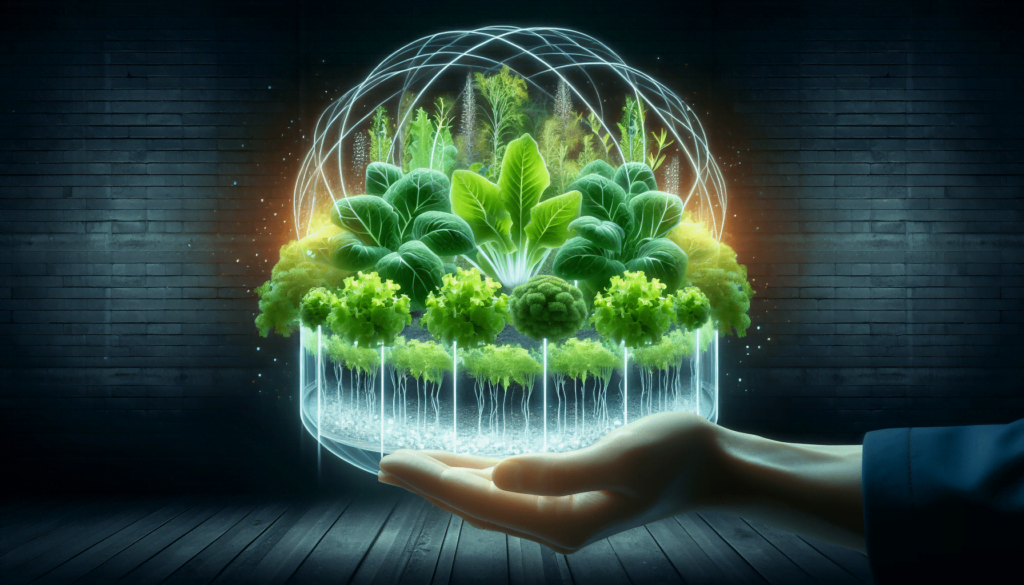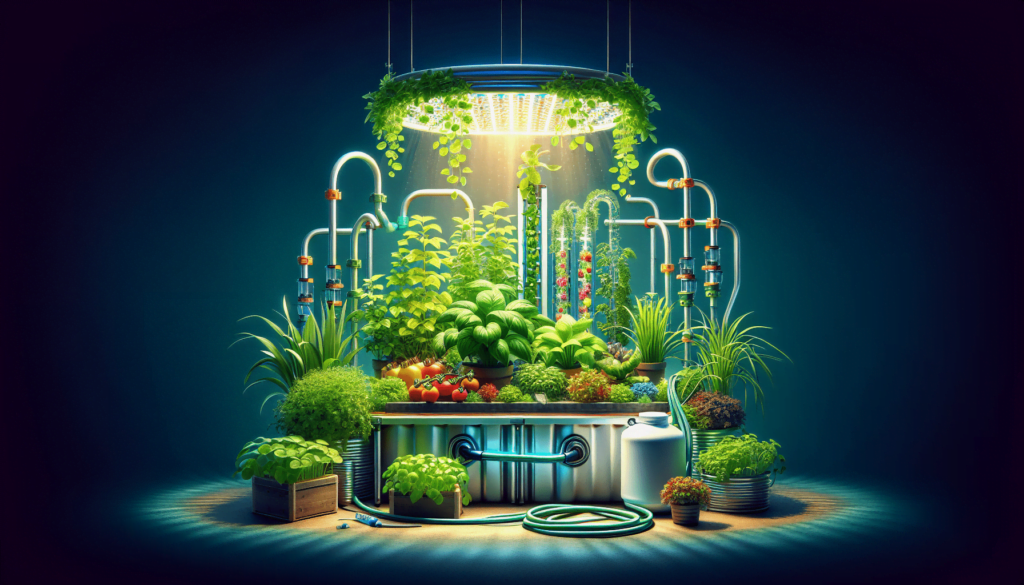Entering the world of hydroponics can seem intimidating at first, but with a little guidance, it’s a breeze. We’ve created “A Beginner’s Guide to Hydroponic Nutrient Solutions” to simplify the understanding and ease you into this high-tech method of gardening. Touching upon various elements like the importance of nutrient solutions, how to create the perfect mix for your plants, and how to rectify common issues, this guide functions as your first step into the fascinating realm that is hydroponics. With us by your side, you’ll find yourself growing healthier and happier plants before you know it!
Understanding Hydroponics
Definition of hydroponics
Hydroponics is a method of growing plants in a water-based, nutrient-rich solution. Unlike traditional farming, it doesn’t involve soil at all. Instead, the root system is supported using an inert medium like peat moss, perlite, vermiculite, or even air. Think of hydroponics as a refined, highly-effective way to provide the perfect nutrient balance to plants.
Popular types of hydroponic systems
There are six main types of hydroponic systems: wick, water culture, ebb and flow (also known as flood and drain), drip, aeroponic, and nutrient film technique (NFT). Each has its own unique characteristics, advantages, and challenges. For example, a wick system is the simplest kind of hydroponic system, while an aeroponic system is a more complex method that involves misting the roots with nutrients.
Benefits of hydroponic gardening
There are numerous benefits to hydroponic gardening. One of the most notable is the increased rate of growth. Plants can grow 20% faster and yield 25% more than their soil-grown counterparts. Hydroponics also uses significantly less water because it can be continuously recirculated. Additionally, there’s far less pest and disease issues, since there’s no soil for them to thrive in. Furthermore, plant nutrients can be controlled precisely, which allows for optimal plant growth and yields.
Introduction to Hydroponic Nutrient Solutions
Importance of hydroponic nutrients
While hydroponics bypasses the need for soil, the need for nutrients still remains. A hydroponic nutrient solution provides the much-needed nutrients in a form that’s ready to be absorbed by the plants. Nutrients are paramount to plant health, and lack of proper nutrients can lead to stunted growth or even plant death.
Difference between soil nutrients and hydroponic nutrients
In the soil, nutrients are usually trapped inside organic matter. They need to be broken down by microbes in order to be absorbed by plants. Hydroponic nutrients, on the other hand, are directly available to the plant roots. These nutrients are usually dissolved into the water and can be adjusted to match a plant’s specific nutritional needs at different stages of growth.
Key components of hydroponic nutrient solutions
Hydroponic nutrient solutions contain a variety of key components that cater to the needs of the plants. This includes macronutrients like Nitrogen, Phosphorus, and Potassium, secondary nutrients like Calcium, Magnesium and Sulfur, and small amounts of micronutrients, such as Iron, Manganese, Boron, Zinc, Copper, Molybdenum, and Chloride.

Essential Elements in Hydroponic Nutrient Solutions
The role of macronutrients: Nitrogen, Phosphorus, and Potassium
Nitrogen, Phosphorus, and Potassium, often abbreviated as N-P-K, are the big three macronutrients that are necessary for overall plant health. Nitrogen promotes leaf growth and the formation of amino acids, the building blocks of life. Phosphorus plays a key role in energy transfer and storage in plants. Potassium ensures proper functioning of metabolic activities and immunity.
Importance of secondary nutrients: Calcium, Magnesium, and Sulfur
Calcium, Magnesium, and Sulfur, while required in smaller quantities than N-P-K, are still integral to plant growth. Calcium aids in the formation of the cell walls, Magnesium is a central element in chlorophyll and vital for photosynthesis, and Sulfur plays a vital role in the production of amino acids, proteins, and vitamins.
The function of micronutrients: Iron, Manganese, Boron, Zinc, Copper, Molybdenum, and Chloride
Micronutrients, despite being needed in trace amounts, are essential for specific physiological functions. For example, Iron is required for chlorophyll synthesis, Manganese aids in the activation of enzymes, Boron helps with cell division and protein formation, and Zinc plays a role in growth hormone production.
Choosing the Right Hydroponic Nutrient Solution
Factors to consider when choosing a nutrient solution
When it comes to choosing the right nutrient solution for your hydroponic system, consider factors such as the type of plants you’re growing, their growth stage, the water quality, and the type of hydroponic system you’re using.
Macro and micronutrient ratios explained
An appropriate balance of macro and micronutrients is essential for the healthy growth of your plants. The ratio of these nutrients may vary depending on the type of plants you’re growing. For instance, leafy green plants might require a higher nitrogen level, while flowering plants might require a higher phosphorus level.
Liquid vs. powdered nutrients
Nutrient solutions are available in both liquid and powdered forms. Each has its own advantages. Liquid nutrients are easy to mix but are heavier to transport and can be more expensive. Powdered nutrients are lightweight, cost-effective, and have a longer shelf-life, but require proper mixing and can be less convenient to use.

Preparing Your Hydroponic Nutrient Solution
Tools required
A few tools are essential when preparing your nutrient solution: A measuring cup for accuracy, gloves for safety, a water quality testing tool to ensure the water is suitable for your plants, and a pH testing tool to verify the pH is at a desirable level for nutrient absorption.
Steps to mixing a nutrient solution
First, fill the hydroponic reservoir with water, measure the appropriate amount of nutrient solution, then add it gradually to the water while mixing slowly. Always follow the instructions on your nutrient sample package to avoid over or under-fertilization. Finally, measure the pH and adjust if necessary.
Storing your nutrient solution
After mixing, you might find yourself with excess nutrient solution. You can store this in clean, light-proof containers. Make sure the containers are airtight to prevent the growth of bacteria or algae. Stored nutrient solutions should be used within a week or so, as their quality can deteriorate over time.
Adjusting the pH Level of Your Nutrient Solution
Understanding pH and its importance in hydroponics
pH (Potential of Hydrogen) is a measure of the acidity or alkalinity of an environment. Optimal pH levels allow plants to efficiently absorb nutrients. If the pH is too high or too low, some nutrients can become unavailable, leading to nutrient deficiencies.
Tools for measuring and adjusting pH
pH meters and testing strips are popular tools for measuring pH. When it comes to adjusting pH, use pH up or pH down solutions to raise or lower the pH levels. Remember to adjust slowly and re-measure after adjusting.
Steps for adjusting the pH level
First, take a pH reading of your nutrient solution. If the pH is outside the optimal range (typically 5.5 to 6.5), you’ll need to adjust it. If it’s too low, add a pH up solution a bit at a time, and if it’s too high, add a pH down solution. Always mix thoroughly before retesting.
Maintaining Your Nutrient Solution
Basic maintenance tips
Regularly monitor your nutrient solution’s pH and electrical conductivity (EC) levels, as these can provide valuable indicators of your plants’ health. Top up your reservoir with water regularly but avoid adding more nutrients unless necessary.
Refreshing and changing your nutrient solution
Over time, the balance of nutrients in your solution can shift as your plants consume them, leading to imbalances. To prevent this, it’s helpful to refresh or change your nutrient solution every two weeks or so.
Signs of nutrient deficiency and excess
Look out for signs like yellow leaves, stunted growth, and weak plants, as these might indicate nutrient deficiencies. On the other hand, excessively dark leaves, burnt leaf tips, or a metallic sheen on your plants might indicate an excess of nutrients.
Common Issues with Hydroponic Nutrient Solutions
Nutrient burn and deficiency
Nutrient burn (caused by excess nutrients) can damage your plants, causing leaf tips to turn brown or black. Conversely, nutrient deficiency can lead to discolouration, slow growth, and weak plants. Ensuring a balanced nutrient solution can prevent both.
pH imbalance
An incorrect pH level can limit the ability of your plants to absorb certain nutrients, leading to deficiencies. Checking the pH regularly and adjusting as necessary can help keep your plants healthy.
Troubleshooting nutrient solution problems
Regular testing and adjustments can prevent many nutrient solution problems. If you spot any issues, take immediate steps to correct them. This could involve adjusting the pH, adding more nutrients, or even refreshing your entire nutrient solution.
Safety Tips When Handling Hydroponic Nutrient Solutions
Proper storage of nutrient solutions
Store your nutrient solutions in a cool, dark place, away from children and pets. This not only ensures safety but also helps preserve the quality of the nutrients.
Handling and disposal of used nutrient solution
When handling nutrient solutions, always wear gloves to protect your skin. When disposing used nutrient solution, do so in a responsible manner. Never pour it down storm drains or in natural water bodies, as it could have negative environmental impacts.
Safety gear for mixing and handling nutrient solution
Safety goggles, gloves, and aprons are good to have when mixing and handling nutrient solutions. Always practice safety first to avoid undesirable accidents.
Resources for Further Learning
Books and guides on hydroponic nutrient solutions
There are numerous books and guides available for anybody interested in digging deeper into the world of hydroponic gardening. They range from beginner-friendly guides to detailed, scientific literature.
Online forums and communities for hydroponics
Up-to-date advice and ideas can often be found on online forums and hydroponic communities. Participating in these platforms can provide valuable insights and experience from fellow hydroponic hobbyists and experts.
Courses and workshops on hydroponics
For hands-on learning experiences, consider taking a hydroponics course or workshop. They offer an engaging way to learn and practice your hydroponics skills.
That wraps up our comprehensive guide to hydroponic nutrient solutions. We hope this serves as a solid foundation for your hydroponic gardening journey. Always remember, like any other skill, it takes time, patience, and a bit of trial and error to master hydroponics. But the rewards, blooming right in front of you, are well worth it. Enjoy your hydroponic gardening adventure!
Forum
Got something to share or a question to ask? Jump in and start a conversation! Whether it’s tips, advice, or just sharing your experiences, we’d love to hear from you. Don’t be shy—your input could inspire or help someone else!- This forum has 1 topic, and was last updated 10 months, 1 week ago by .
- Topic
- Voices
- Last Post
- You must be logged in to create new topics.


